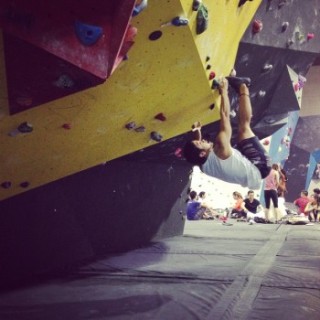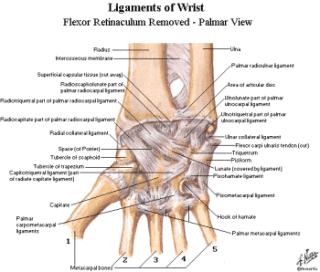
Dr. Jon hanging around at Hub Climbing
Let’s face it. Rock climbing by nature can be pretty tough on your wrists. You hang your entire body weight off of one arm, or both, lock off and balance while you reach or lunge towards the next hold. Invariably every climber will make an attempt at a route and say “Ooh my wrist felt awkward there”, “Ah that sloper hurt my wrist”, or “my wrists are too weak for that”. That is rock climbing with a wrist injury.
Wrist Anatomy
Let’s start with a brief overview of wrist anatomy. Your wrist is composed of 8 bones in 2 rows that interact with the bones of your forearm – the radius and the ulna. On every bone there are articular surfaces, joint capsules, a plethora of ligaments, and attached to the base of your ulnar styloid and the edge of your radius is whats known as the Triangular fibrocartilage discus or complex (also known as the TFCC) This TFCC is an articular disk that functions to extend the articulating surface of the distal radius, assist in load transmission and partially absorb load and provide a strong yet flexible connection to allow for forearm rotation. On top of all this you have blood supply, nerves, retinaculum, fascia and your skin.

Rock climbing and wrist injuries.
The reason I spend so much time describing the TFCC is that is one of the most common injuries sustained by climbers and usually begins as a slow creeping ache-ing type pain along the medial side (side where your pinky is) of the wrist right into the joint. It can also be sharp with wrist extension or bending into that direction. The TFCC is injured by tearing it, the ligaments that support it, traumatic compression such as falling onto an outstretched hand and by pulling on slopers. A TFCC injury does not have to be a career ending injury and proper regime of relative rest, rehabilitative exercise and supportive taping can go a long way.
Because of how complex the wrist can be, you can imagine the list of wrist injuries goes on and on from repetitive strain, pulley rupture, fractures, avulsions, cysts, nerve compression, carpel tunnel- to name a few. Based on this knowledge, as Dr. Julian Saunders puts it so well “Diagnosis is the key to injury management, not rest”.
An ounce of preventative care is worth a pound of repair. It is much easier to progressively train and improve your sloper strength gradually and consistently rather then doing the same thing over and over and expecting a different result. Don’t just train hard, train smart. If you start to notice your wrist is sore take a minute and ask yourself why. If you can’t answer why, ask for help! You can find always email me at jon.leung.dc@gmail.com for an online consult, book an appointment or stop me at Hub Climbing at Applecreek and woodbine and ask me. I climb there every Monday and Thursday evenings. The staff may be able to point me out =D.
To leave you off with some generic wrist prevention strategies while climbing I give you 5 tips!
1. Warm up. Even before you climb, clasps your hands together palm to palm and do 30 wrist circles one way, and 30x the other way. 30s static holds in wrist flexion, and extension and some dynamic end range wrist mobilizations.
2. Warm up! This means when you get onto the wall, climb the easiest routes in the gym and spend time simply grasping and shifting your weight onto jugs, completing 5-10 climbs of the easy stuff moving very slowly and deliberately before progressing up the grades. Slowly progress through the holds, with pinches and slopers last. Don’t just jump on “fresh” and work the same problem you didn’t send with your last gym session!
3. Listen to your body. If you feel pain with a specific movement or a specific hold type, avoid it! Ask yourself why and figure it out before simply climbing through the pain.
4. Tuck your arms. This goes without saying but if you’re falling, DO NOT extend your hand to break your fall. You should be well versed in the art of falling to safely and comfortably boulder. Know your limits and climb within them.
5. Balance your muscles. Climbing requires you to grip and flex your hand. Grip and flex your hand, Grip and flex your hand. Get it? Our bodies love balance so take some time to equalize the strength in your hands and wrist and work with opening your hands against resistance. A great way to do this is with a bag of rice and simply opening your hand and extending your wrist in it.

Comments are closed.